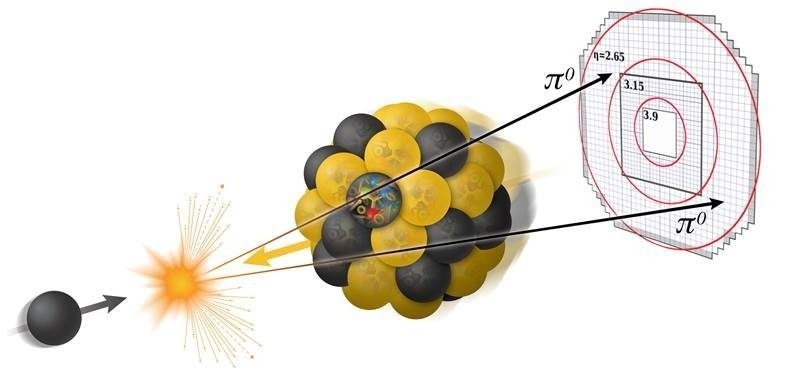The collision of protons with bulkier ions (atomic nuclei) has been done by nuclear physicists to examine the basic constituents that are responsible for composing those ions.

In collisions of a proton and a heavy nucleus, scientists saw a suppression in back-to-back pairs of a type of pions (π0 particles). This indicates fewer single quark-single gluon interactions, which is likely due to gluons in heavy nuclei recombining. Image Credit of Brookhaven National Laboratory.
Through tracking the particles that flow out of the collisions, it is possible for nuclear physicists to zoom in beyond the ions’ protons and neutrons to study those particles’ innermost building blocks—called gluons and quarks.
The newly obtained outcomes showed that the suppression of some back-to-back pairs of particles arises from interactions of single quarks from the proton with single gluons in the bulkier ion.
With the heaviest nuclei, the suppression was highest in collisions. The outcomes show that gluons in bulky nuclei tend to reunify, as anticipated by the theory of the strong force, called quantum chromodynamics.
The Impact
Earlier experiments have shown that when ions are expedited to high energies, there is a division of gluons to multiply into fairly high numbers. However, researchers doubt whether it is possible to execute gluon multiplication forever.
In nuclei that move close to the speed of light, where relativistic motion levels the nuclei into speeding gluon “pancakes,” overlapping gluons begin to recombine.
A step toward proving that gluons attain a postulated steady state known as saturation is through seeing evidence of recombination, where gluon splitting and recombination become balanced. The new outcomes correspond to theoretical models postulating this saturated state.
Summary
The STAR detector at the Relativistic Heavy Ion Collider, a Department of Energy Office of Science user facility, was utilized by researchers with the STAR Collaboration. This was done to look for signs of gluon recombination.
They were looking for a telltale signal produced in collisions of protons consisting of a range of ions when a single quark from the proton interacts with a separate gluon in the ion. That signal is known to be a pair of neutral pions striking a forward detector at back-to-back angles.
If gluons present in the nuclei are subjected to recombination, researchers would anticipate noticing a suppression in this back-to-back signal since only fewer gluons would be available for the quark-gluon interactions. The physicists searched for the signal in collisions of protons with varied-sized ions.
The larger the ion, gluon recombination would be more notable—the theorists forecast. That is because heavy ions (nuclei) consist of more quark-and-gluon-consisting neutrons and protons.
When expedited to near the speed of light, such ions tend to flatten out, thereby making the plentiful gluons overlap combine. Larger nuclei consisting of more gluons must mean more suppression and more merging in the signal.
That is exactly what was discovered by the researchers. The study outcomes provide proof that gluons recombine and a powerful suggestion that gluon splitting and recombination could generate the saturated state that has been anticipated.
This study was financially supported by the Department of Energy Office of Science, the Nuclear Physics program, the National Science Foundation, and a range of international agencies listed in the published paper.
Journal Reference
Abdallah, M. S., et al. (2022) Evidence for Nonlinear Gluon Effects in QCD and Their Mass Number Dependence at STAR. Physical Review Letters. doi.org/10.1103/physrevlett.129.092501.